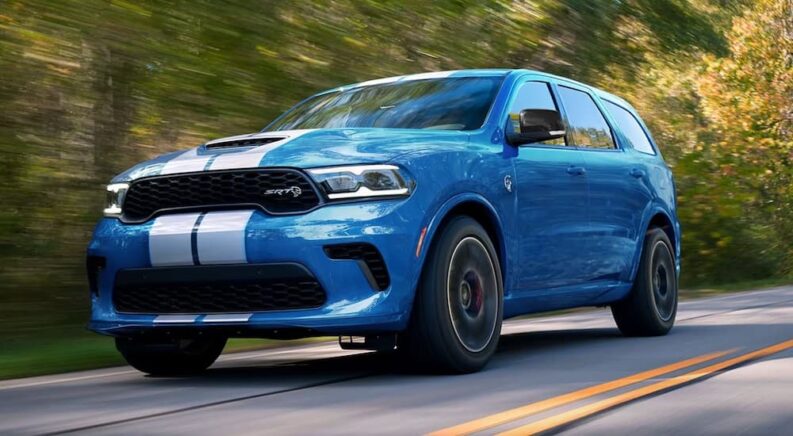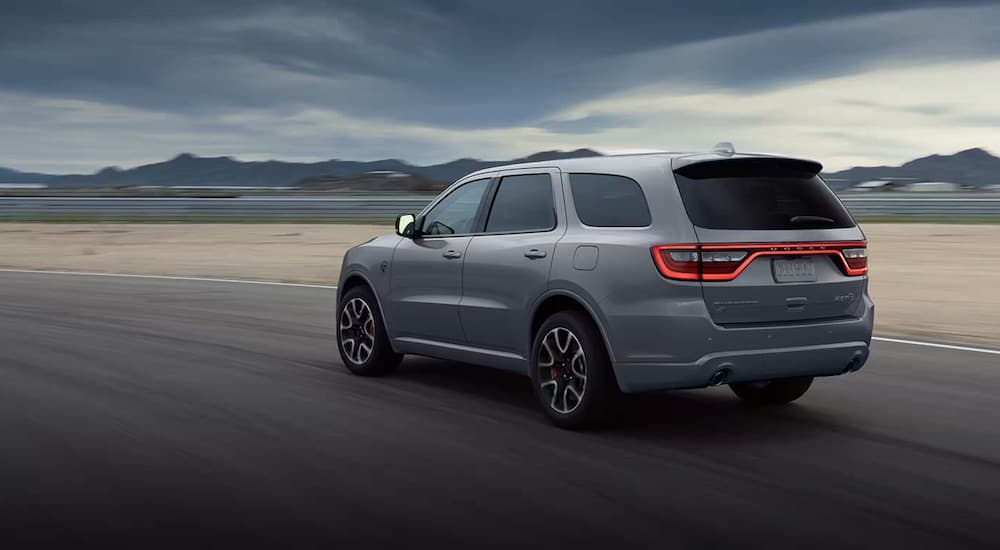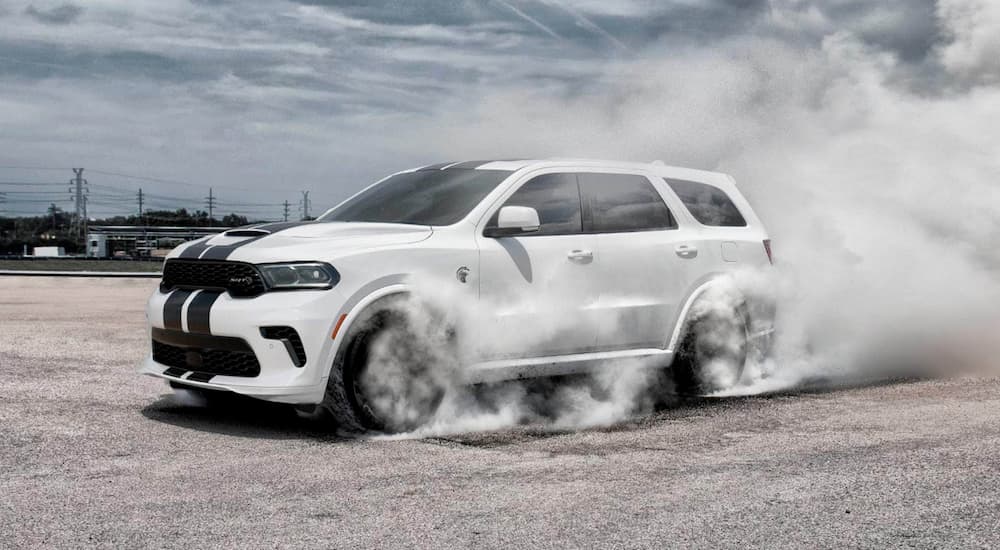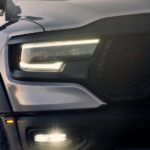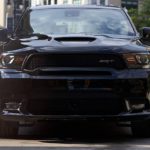When it comes to versatility, few segments can touch the humble SUV. Offering a clever mix of power, cargo room, and utility, today’s SUVs are some of the most well-rounded vehicles on the road. As adept at towing and hauling as they are at comfortably fitting the whole family and giving drivers a commanding view of the road, there’s a reason SUVs have steadily outsold the traditional sedan over the last decade. That said, sportiness hasn’t always been their forte. Sure, “Sport” might be in the segment name, but this typically refers to a model’s off-road chops rather than its pure athleticism—and then there’s the Durango SRT Hellcat.
This performance-focused version of Dodge’s full-size SUV combines everything there is to love about the segment with the sort of high-octane performance that wouldn’t be out of place at your local race track. With the ability to tow 8,700 lbs and speed from zero to sixty in just 3.6 seconds, it’s fair to say that a visit to your local Dodge dealer won’t turn up many vehicles like the Durango SRT Hellcat. This SUV’s unique fusion between power and speed can largely be credited to the model’s supercharged 6.2-liter Hellcat HEMI V8, which produces a monstrous 710 hp—but there’s just one problem: it isn’t long for this world.
2024 marks the last year for the Durango SRT Hellcat (or any model bearing the Hellcat name) as Dodge plans to phase out the brawny V8 at the end of this year. Instead of crying because it’s over, I’m going to smile about the fact that such an unhinged fusion of utility and performance ever made it to the market in the first place. So, let’s trace the history of Dodge’s Hellcat engine, see which models it’s powered to checkered-flag glory, and take a look at this last-of-its-kind Durango…
HEMI History
The Hellcat is really just the latest iteration of a line of powerful engines that have graced Chrysler models since 1951. Lovingly known as a HEMI, these V8s can be found in some of the most powerful, performance-minded vehicles to ever bear the Chrysler name. But what makes a HEMI so special? It all comes down to the ultra-efficient shape of its hemispherical combustion chambers.
Boasting a superb surface-to-volume ratio, two large overhead valves, and minimal heat loss, the HEMI burns fuel more efficiently and quickly than engines designed with the typical wedge- or bathtub-shaped combustion chamber thanks to its ability to create more pressure. There are some downsides to the design—including valve actuation and HEMI’s tendency to experience a little pre-detonation or “knocking” when using the wrong fuel—but for those seeking the ultimate in V8 power, it’s hard to beat.
While HEMI-powered vehicles have been a mainstay of the Chrysler lineup since the early 1950s, the engine was actually first developed at the tail-end of World War II as a potential replacement for the radial Pratt & Whitney engine found in the Republic P-47 Thunderbolt fighter plane. While Chrysler did give the engine a trial run, the war wound down before any production models could be outfitted with the innovative HEMI. The experiment did prove to be a vital bit of R&D and would go on to inspire the production of the Hellcat itself by allowing the automaker to experiment with the HEMI design.
The HEMI would receive its first deployment in 1951 on the Chrysler New Yorker, Imperial, and Saratoga, though at that time, the 180-hp engine was still known as the FirePower. Fellow Chrysler brands DeSoto and Dodge would refer to their own hemispherical engines as the FireDome and Red Ram, respectively, but all these models were still a HEMI in all but name. The 331-cubic-inch HEMI would prove itself right out of the gate, powering auto racer Briggs Cunningham to a 1953 class win behind the wheel of his HEMI-powered Cunningham C-5R.
Enter the Hellcat
Chrysler would continue to improve on the HEMI formula throughout the decades, releasing new generations of the engine in 1964 and 2003. The third-generation HEMI would mark a particularly notable improvement over previous designs, moving away from a purely hemispherical design while adding a coil-on-plug ignition system and two spark plugs per cylinder to create more consistent combustion while also reducing the engine’s total emissions.
New variable valve displacement technology also aided in efficiency by allowing some HEMI models to deactivate two cylinders on each bank. The 5.7-liter HEMI was first deployed on Dodge’s 2003 Ram pickups and would come to grace the Durango in 2004. A 6.1-liter version would be added in 2005, but it was the 6.2-liter version that would finally let the Hellcat out of the bag.
The Hellcat wasn’t just the largest and most powerful engine ever produced by Chrysler; it was also the first supercharged HEMI in the automaker’s long history. The Hellcat was first conceived in 2011 as part of a corporate product forum that served as a testing ground for bold new ideas. While engineers originally proposed a 600-hp HEMI that would make the Dodge Challenger the most powerful muscle car in the market, the company was leapfrogged by Ford’s introduction of the Shelby GT 500 Mustang.
The Chrysler team set its eyes on a new 675-hp goal but was saddled with the same production deadline as the original 600-hp version. The company built an entirely new facility to develop and test the record-breaking engine, and the 707-hp Hellcat was introduced to the world in the 2015 Dodge Challenger SRT Hellcat. “We built it because we could,” said Chris Cowland, director of Street and Racing Technology (SRT) powertrain development. “We wanted to make a statement and move the brand forward.”
Named for the Grumman F6F Hellcat fighter plane, the new V8 spoke to the HEMI’s military pedigree. A twin-screw supercharger with boost-regulating features—including an electronic bypass valve and integral charge coolers—allowed this massive engine to keep its cool while electronically-controlled exhaust valves gave the big cat a distinctive growl. The resulting 707 hp and 650 lb-ft of torque easily made the Hellcat the world’s most powerful muscle car engine until it was eclipsed by the 808-hp Demon in 2018.
Not Your Average SUV
The Hellcat finally found its way under the hood of the full-size in 2021 when Dodge introduced the Durango SRT Hellcat. The supercharged 6.2-liter V8 was able to churn out 710 hp, putting the Durango in a class of its own when it came to the high-performance SUV segment. At first, the Durango SRT Hellcat seemed like a bit of a tease: Dodge offered the SUV for just one year before discontinuing it at the end of 2021 due to tightening emission requirements. Luckily, the brand found a workaround and treated drivers to new versions in both 2023 and 2024.
So, what does the 2024 model have to offer? The Hellcat V8 is an obvious highlight, but Dodge has paired the engine with enough premium components to keep it from feeling like a novelty. The all-wheel drive SUV is outfitted with a Brembo brake system featuring 15.75-inch front rotors paired with six-piston calipers and 13.8-inch rear discs featuring four-piston calipers. The result is a 5,534-lb full-size SUV that can brake from 70 mph down to zero in as little as 165 feet. An adaptive suspension provides a smooth ride while riding on the 20-inch wheels done up in Pirelli all-season tires. It’s a robust package but a necessary one when you consider the SUV’s considerable heft and output.
As I mentioned at the top, the Durango SRT Hellcat’s most noteworthy stat might be its double major in towing and power. The high-performance model manages to achieve the same 8,700-lb towing capacity as the standard-issue Durango thanks to its robust body-on-frame construction while providing a zero-to-sixty time of 3.6 seconds. The Hellcat-powered Durango can also run the quarter-mile in twelve seconds and get the speedometer all the way up to 180 mph—a rare mix in a full-size SUV. Unsurprisingly, this all comes at the cost of efficiency, with the Durango SRT Hellcat delivering 12 MPG in the city and 17 MPG on the highway—but it’s a small price to pay for the one-of-a-kind driving experience it can deliver.
Starting at $103,590, the Durango SRT Hellcat packs more than enough goodies to justify the price. The engine alone accounts for at least $18,000 (based on the price of the crate model), but Dodge certainly hasn’t skimped when it comes to the finishing touches. The cabin is reminiscent of the Charger and Challenger Hellcats, right down to the flat-bottom steering wheel with an illuminated SRT logo, paddle shifters, and Nappa leather upholstery.
On the tech front, a 10.1-inch display running Dodge’s Uconnect 5 infotainment system replaces the 8.4-inch screen found on lesser trims, while six integrated USB ports and an available rear entertainment system with two 9.0-inch screens provide mobile power and digital distractions for each passenger. Software highlights include a voice command system powered by Amazon Alexa, Apple CarPlay and Android Auto, and an available Wi-Fi hotspot, but it’s the Dodge Performance Pages feature that’ll be of the most interest to the true Hellcat fans. With the ability to log performance data like acceleration, g-forces, and quarter-mile times, Dodge Performance Pages turn every drive into a fun little contest to set a new personal best.
As has become a tradition with the Hellcat-powered models, Dodge is sending the Durango SRT off with a bang with the Last Call Special Edition. Limited to just 1,000 units, the SRT 392 AlcHEMI engine doesn’t provide an upgrade in power (the 392 model actually maxes out at 475 hp), but it certainly boasts a striking visage with four limited-edition colors that match the brake calipers, fender decals, stripes, and interior stitching to the exterior body color. Black-painted wheels and exhaust tips set the SRT 392 AlcHEMI apart from the crowd, while a darker grille and liftgate badge give it a moody look.
The Last of the Durango Hellcat
The Hellcat might be going extinct, but it sure was a fun ride while it lasted. I understand Dodge’s decision to sunset the brawny V8 in an era where efficiency dictates design, but that doesn’t mean I have to like it. The HEMI was already one of the American auto industry’s standout engines, but the Hellcat elevated that V8’s reputation to a whole other level, adding a supercharger to create some of the most notable muscle cars (and SUVs) that the road has ever seen.
The Durango SRT Hellcat will be remembered as a genre-defying beast of an SUV, allowing drivers to combine all the segment’s perks with the type of performance that’ll get you a little giddy every time you sit behind the wheel. Maybe we’ll see a similarly performance-focused model paired with an EV powertrain sometime in the future, but it’ll be tough to recreate the pure excitement that the Dodge Durango SRT Hellcat was able to provide.

